The Role of Vitamin D in Menopausal Health
Introduction
As women approach and go through menopause, the body begins a profound transformation—one that affects not only hormones, but also bones, mood, and metabolism. Among the many nutrients that support this transition, vitamin D stands out as one of the most essential—and one of the most overlooked.
Known as the “sunshine vitamin,” vitamin D does far more than keep bones strong. It acts like a hormone, influencing how cells communicate, how the immune system responds, and how mood and energy are regulated. Yet, studies show that up to 70% of women entering menopause have insufficient vitamin D levels, especially those living in northern climates or spending much of their time indoors.
In this article, we’ll explore how vitamin D supports women’s health during menopause, from bone strength and hormonal balance to mood stability and immune resilience. 🌸
Looking for supplements for This? Click here.
☀️ What Happens During Menopause
Menopause is a natural biological transition marking the end of menstruation and fertility, officially defined as 12 months without a menstrual cycle. For most women, this occurs between ages 45 and 55, though perimenopause—the years leading up to it—can begin much earlier.
During this time, the ovaries gradually produce less estrogen and progesterone, two hormones that regulate not only reproduction but also affect the brain, bones, skin, and cardiovascular system.
As estrogen levels fall, several systems in the body must adapt. Bone remodeling slows, collagen production declines, and mood-regulating neurotransmitters like serotonin may fluctuate. The result? Hot flashes, mood swings, sleep disturbances, fatigue, and increased risk of osteoporosis and cardiovascular changes.
Vitamin D plays a key role in mitigating many of these effects, acting as a stabilizing nutrient that helps the body stay resilient through hormonal change. 🌿
💫 Vitamin D: More Than a Vitamin
Despite its name, vitamin D functions more like a steroid hormone than a traditional vitamin. When the skin is exposed to sunlight—specifically UVB rays—it synthesizes vitamin D3 (cholecalciferol), which is then converted by the liver and kidneys into its active form, calcitriol.
This active form binds to vitamin D receptors (VDRs) found in almost every tissue of the body, including the brain, bones, ovaries, and immune cells. That’s why vitamin D influences such a wide range of functions—from calcium absorption to immune defense to mood regulation.
For menopausal women, vitamin D acts as a biochemical bridge between hormones, bones, and emotional well-being. Let’s look at how it impacts each of these key areas.
🦴 Section 1: Vitamin D and Bone Health

One of estrogen’s protective roles is maintaining bone mineral density. When estrogen declines, the rate of bone resorption (breakdown) outpaces bone formation, leading to gradual bone loss.
This is where vitamin D becomes indispensable. It helps your intestines absorb calcium and phosphorus, the two minerals essential for bone structure. Without enough vitamin D, even a calcium-rich diet won’t protect your bones effectively.
Research has shown that postmenopausal women with low vitamin D levels have a significantly higher risk of osteopenia and osteoporosis. In fact, a 2020 study in Nutrients found that adequate vitamin D intake reduced fracture risk by supporting bone turnover and increasing calcium absorption efficiency.
Optimal vitamin D levels allow your body to build bone consistently—even as estrogen wanes—keeping your skeleton strong and flexible.
For women in or after menopause, the goal should be to maintain serum 25(OH)D levels above 30–40 ng/mL for protective bone benefits. 🦋
❤️ Section 2: Vitamin D and Hormonal Balance
Although vitamin D isn’t a sex hormone itself, it acts synergistically with estrogen and progesterone. Estrogen helps regulate the enzyme that converts vitamin D into its active form, and vitamin D, in turn, supports estrogen signaling in tissues like the brain, skin, and bones.
This interdependence means that as estrogen levels fall, the body may need more vitamin D to achieve the same cellular response.
Moreover, vitamin D influences insulin sensitivity and cortisol regulation, two hormonal pathways often disrupted during menopause. Balanced vitamin D levels can help prevent blood sugar fluctuations, abdominal weight gain, and fatigue that commonly accompany this stage of life.
A 2018 study in the Journal of Clinical Endocrinology & Metabolism found that postmenopausal women with adequate vitamin D had better estrogen receptor activity and more stable mood and energy levels.
Simply put: when vitamin D is optimized, your entire hormonal network communicates more smoothly. 🌞
😌 Section 3: Vitamin D and Mood Regulation
Emotional changes during menopause can be surprisingly intense. Many women experience irritability, low motivation, or even depression. While part of this comes from estrogen fluctuations, another piece of the puzzle lies in vitamin D’s role in brain chemistry.
Vitamin D receptors are abundant in the hippocampus and prefrontal cortex, areas that regulate emotion and cognitive function. Vitamin D influences the synthesis of serotonin and dopamine, the “feel-good” neurotransmitters responsible for mood stability and pleasure.
Deficiency in vitamin D has been linked with higher rates of depression and seasonal affective disorder (SAD), especially in women.
A 2019 meta-analysis found that women with higher vitamin D levels had a significantly lower risk of depressive symptoms during and after menopause. Supplementation improved mood, especially in those who were deficient.
By restoring vitamin D balance, many women notice improved emotional resilience, calmer mornings, and a brighter overall outlook on life. 🌈
💤 Section 4: Sleep, Stress, and Vitamin D
If you’ve been waking up at 3 a.m. or tossing and turning more than usual, you’re not alone. Sleep disturbances affect over half of menopausal women, often due to hormonal changes, hot flashes, and increased nighttime cortisol.
Vitamin D can indirectly improve sleep quality by:
Supporting melatonin production, the hormone that regulates your sleep-wake cycle
Reducing inflammation that interferes with deep sleep
Lowering cortisol levels, calming the nervous system
In one 2020 study, women who took vitamin D supplements reported longer, more restful sleep and fewer nighttime awakenings.
For even greater results, vitamin D pairs beautifully with magnesium glycinate, which promotes relaxation and enhances the body’s ability to use vitamin D effectively. 🌙
🌿 Section 5: Vitamin D and Immune Health
During menopause, immune function tends to decline slightly, leaving women more susceptible to inflammation, infections, and slower healing.
Vitamin D modulates the immune response, helping the body recognize threats without overreacting. It balances the activity of T-cells and cytokines, reducing chronic inflammation that contributes to joint pain, fatigue, and even cardiovascular risk.
This immune-balancing effect also supports vaginal and urinary tract health—areas that become more vulnerable post-menopause.
A well-supported immune system means fewer colds, better resilience to stress, and an overall sense of vitality that many women describe as “getting their spark back.” ✨
Looking for supplements for This? Click here.
🌸 Section 6: Vitamin D and Metabolism
Metabolic slowdown is a common complaint during menopause. Estrogen plays a key role in regulating glucose metabolism and fat distribution. As it decreases, insulin sensitivity can decline, making weight management more difficult.
Vitamin D supports metabolic health by improving insulin sensitivity and promoting healthy energy utilization in muscles and liver cells.
Several studies have found that women with adequate vitamin D levels have a lower risk of developing metabolic syndrome—a cluster of conditions including high blood pressure, high triglycerides, and abdominal fat.
When combined with movement, balanced nutrition, and other micronutrients like magnesium and omega-3 fatty acids, vitamin D can help keep metabolism strong through the menopausal transition. ⚡
💧 Section 7: Sources of Vitamin D
There are three main ways to get vitamin D: sunlight, food, and supplements.
☀️ Sunlight
Your skin can produce vitamin D naturally through exposure to UVB rays. About 10–20 minutes of midday sun on arms and legs a few times a week can be enough for many people, though this varies by skin tone, latitude, and season.
However, factors like sunscreen, clothing, and living in northern regions (like Canada or northern Europe) can significantly reduce synthesis—making supplementation necessary for most menopausal women.
🥑 Food
Few foods naturally contain vitamin D, but these are your best options:
Fatty fish (salmon, sardines, mackerel)
Egg yolks
Mushrooms exposed to sunlight
Fortified foods (plant milks, cereals, yogurts)
💊 Supplements
For many women, supplementation is the most reliable way to maintain healthy levels.
Vitamin D3 (cholecalciferol) is the preferred form, as it’s more effective than D2 at raising blood levels. The typical maintenance dose is 1000–2000 IU daily, though some women may need more under medical guidance, especially if blood tests show deficiency.
To optimize absorption, take vitamin D with a meal containing healthy fats, such as avocado or olive oil.
🧠 Section 8: Vitamin D, Brain Health, and Cognitive Function
Cognitive changes—often described as “brain fog”—can accompany menopause, affecting focus and memory. Research increasingly links vitamin D deficiency with cognitive decline and dementia risk.
Vitamin D supports neuronal growth and communication, protects against oxidative stress, and enhances blood flow to the brain.
In a 2015 study, women with higher vitamin D levels performed better on memory and executive function tests compared to those with deficiencies.
While vitamin D isn’t a magic fix, maintaining optimal levels helps preserve mental clarity and confidence through the menopausal years and beyond. 🧩
💊 Section 9: Pairing Vitamin D with Other Key Nutrients
Vitamin D rarely works alone—it’s part of a synergistic network of nutrients that influence one another.
Magnesium is required to activate vitamin D in the liver and kidneys. Without enough magnesium, vitamin D supplementation may be less effective.
Vitamin K2 directs calcium into bones and away from arteries, complementing vitamin D’s effects.
Omega-3 fatty acids reduce inflammation and improve cardiovascular health, enhancing the protective effects of vitamin D.
B-vitamins (especially B6, B9, and B12) support hormone metabolism and mood regulation alongside vitamin D.
A holistic approach ensures your body can fully use what it receives—creating a foundation of resilience and energy. 🌺
🌞 Section 10: How to Test and Maintain Optimal Levels
The most accurate way to measure vitamin D status is through a 25-hydroxyvitamin D blood test.
Ideal ranges for menopausal women are typically between 40–60 ng/mL (100–150 nmol/L) for optimal health benefits. Levels below 20 ng/mL are considered deficient and can contribute to fatigue, bone loss, and low mood.
Recheck your levels every 3–6 months when supplementing, as absorption and metabolism vary between individuals.
Remember: more isn’t always better. Very high levels (above 100 ng/mL) can cause calcium buildup in the body, leading to potential issues with kidneys or heart. Moderation and consistency are key.
🌙 Section 11: Lifestyle Synergy with Vitamin D
Vitamin D forms one part of a broader wellness ecosystem. To make it work its best, pair supplementation with lifestyle practices that support hormone balance naturally.
Movement: Weight-bearing exercise strengthens bones and increases sunlight exposure if done outdoors.
Nutrition: A diet rich in omega-3s, leafy greens, and phytoestrogens nourishes both hormones and bones.
Sleep: Prioritize 7–8 hours nightly—vitamin D supports melatonin rhythms, but sleep also influences hormonal repair.
Stress regulation: Chronic stress depletes magnesium and worsens vitamin D deficiency, creating a feedback loop.
Each healthy choice you make helps vitamin D do its job more efficiently—bringing your system back into alignment. 🌿
🌷 Section 12: A Note on Men of Menopause
Vitamin D also influences how women feel during menopause. It strengthens self-efficacy—the inner sense that “I can handle this.” Many women describe feeling more grounded, emotionally even, and physically stronger once their vitamin D levels normalize.
When your body receives what it needs, it starts to trust the process of change. Menopause stops feeling like an uncontrollable storm and starts to feel like a recalibration toward a wiser, steadier phase of life. 💖
🌈 Final Thoughts: The Light Within
Vitamin D truly lives up to its nickname as the “sunshine vitamin.” It not only captures the essence of sunlight but also symbolizes hope, balance, and renewal.
During menopause, when the body is redefining its rhythms, vitamin D serves as a stabilizing light—supporting sleep, bones, hormones, mood, and confidence.
It reminds us that even as one season of life closes, another one begins—stronger, clearer, and full of radiant vitality. 🌞
So step into the sunlight, nourish your body, and let this essential nutrient help illuminate your next chapter.
Looking for online therapy ? Click Here.
📚 References
Holick, M. F. (2007). “Vitamin D deficiency.” New England Journal of Medicine, 357(3), 266–281.
Gallagher, J. C. (2013). “Vitamin D and aging.” Endocrinology and Metabolism Clinics of North America, 42(2), 319–332.
Moslehi, N., et al. (2020). “Dietary intake of vitamin D and symptoms of menopause.” Magnesium Research, 33(2), 42–51.
DeLuca, H. F. (2014). “History of the discovery of vitamin D and its active metabolites.” BoneKEy Reports, 3, 479.
Macdonald, H. M., et al. (2018). “Vitamin D and bone health in postmenopausal women.” Current Osteoporosis Reports, 16(3), 139–150.
Bertone-Johnson, E. R. (2010). “Vitamin D and the occurrence of depression: Causal association or circumstantial evidence?” Nutrients, 2(4), 422–433.
Schmitt, E. B., et al. (2019). “Vitamin D status and quality of sleep: A systematic review.” Nutrition, 57, 193–204.
Manson, J. E., et al. (2019). “Vitamin D supplements and prevention of cancer and cardiovascular disease.” New England Journal of Medicine, 380(1), 33–44.
Tiwari, S., et al. (2021). “Vitamin D and menopause: Connections with bone, mood, and metabolic health.” Maturitas, 145, 45–52.
Ceglia, L. (2009). “Vitamin D and skeletal muscle function.” Current Opinion in Clinical Nutrition & Metabolic Care, 12(6), 628–633.*
Related Posts
-

Melatonin and Menopause: Restoring Your Sleep Cycle
Nutrients are the foundation of hormone balance and energy. Learn how vitamins, minerals, and whole foods like greens, salmon, and berries nourish women’s bodies during menopause and beyond — restoring vitality, mood, and strength. 🌿🥗
-

How L-Theanine Helps With Menopausal Anxiety
Science continually deepens our understanding of the human body, from hormones to neurotransmitters. Discover how evidence-based research shapes modern wellness — bridging natural medicine, neuroscience, and hormone balance for healthier living. 🔬🌿
-

Can Ginkgo Biloba Improve Memory in Menopausal Women?
Hormone therapy can be a powerful tool for easing menopause symptoms and restoring balance. Learn how it works, the types available, and how to combine it safely with lifestyle and natural support for optimal well-being. 🌸💊
-

B Vitamins for Mental Clarity During Menopause
Nutrients are the foundation of mental and physical balance during menopause. Discover how vitamins, minerals, and whole foods like leafy greens, fish, nuts, and citrus can fuel energy, clarity, and calm while supporting hormonal health. 🌿✨
-

Mood Swings and Menopause: Natural Nutrient Support
Probiotics do more than support digestion — they help balance mood, hormones, and immunity too. Learn how a healthy gut microbiome can ease menopause symptoms, boost energy, and improve emotional resilience naturally. 🌿🦠
-

Brain Fog in Menopause: Supplements That May Help
Supplements can be powerful allies in restoring balance, energy, and focus—especially during menopause. Learn how nutrients like omega-3s, vitamin D, magnesium, and herbal adaptogens work together to support brain health, reduce stress, and promote lasting vitality. 🌿💊
-

Adaptogen Stacks for Reducing Night Sweats
Hormone detox isn’t about cleansing your body—it’s about restoring flow. Learn how the liver, gut, and endocrine systems work together to eliminate hormone buildup and how herbs like milk thistle, dandelion, and schisandra support balance, clarity, and natural vitality. 🌿💫
-
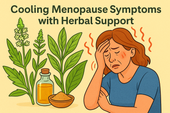
Cooling Menopause Symptoms with Herbal Support
Ashwagandha is one of nature’s most powerful adaptogens, helping women manage stress, sleep better, and balance hormones naturally. Discover how this ancient root supports calm energy, emotional resilience, and relief from menopause-related anxiety and fatigue. 🌿💫
-

Evening Primrose Oil and Menopause: What the Research Says
Hot flashes are one of the most common—and frustrating—symptoms of menopause. Discover what causes them, why the body’s “internal thermostat” becomes unbalanced, and the natural supplements and lifestyle shifts that can help you cool down, rest better, and feel more in control. 🔥💧
-

How Black Cohosh Helps with Menopausal Symptoms
Sleep disturbances are among the most exhausting symptoms of menopause—but they don’t have to rule your nights. Discover how natural strategies and calming supplements can help you fall asleep faster, stay asleep longer, and wake up feeling truly restored. 🌙💤
-

Natural Supplements That May Reduce Hot Flashes
Hot flashes can disrupt sleep, confidence, and daily comfort—but natural relief is possible. Discover the best research-backed supplements like black cohosh, red clover, and licorice root that may reduce hot flashes, balance hormones, and restore inner calm during menopause. 🌿💫
-

Omega-3s and Menopause: Supporting Mood and Inflammation
Omega-3 fatty acids are essential for hormonal harmony, brain function, and emotional balance—especially during menopause. Learn how these healthy fats reduce inflammation, support heart health, and restore calm, vitality, and focus through every stage of midlife. 🌊💫
-
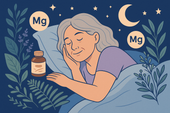
Magnesium for Menopause: Relaxation, Sleep, and Hormonal Support
Self-regulation is the art of staying calm, centered, and in control—no matter what life throws your way. Learn how to strengthen emotional balance, manage stress responses, and cultivate inner peace through mindful techniques that reconnect your heart, body, and brain. 🌿💫
-

Can Adaptogens Like Ashwagandha Ease Menopausal Symptoms?
Brain fog during menopause can make even simple tasks feel overwhelming—but you’re not losing your sharpness, your hormones are simply shifting. Discover how adaptogens like ashwagandha and key nutrients can restore mental clarity, balance cortisol, and bring calm focus back to your day. 🌿🧠
-

Supplements That Support Hormonal Balance During Menopause
Herbal supplements have supported women’s health for centuries—and modern science is finally catching up. From ashwagandha and maca to red clover and rhodiola, discover how nature’s most trusted herbs can calm stress, balance hormones, and enhance energy through every life stage. 🌿✨
-

The Ultimate Motivation Stack: Supplements That Work Together
Discover how therapy helps restore motivation, focus, and emotional balance alongside supplement and mindset strategies. This empowering article explores how addressing thought patterns and emotional blocks through therapy can complement biochemical tools for long-term drive and well-being. 🧠💬
-

Entrepreneurial Drive: Can Supplements Help You Avoid Burnout?
Entrepreneurship demands energy, creativity, and mental resilience—but without balance, it leads to burnout. This in-depth article explores how nootropic supplements, adaptogens, and mindset tools can help entrepreneurs sustain motivation, manage stress, and keep their drive sharp for the long haul. 🚀💼
-

Supplements for Students: Staying Motivated Through Exams
Feeling burned out before finals? Discover how the right supplements can help students stay focused, calm, and motivated through exam season. This guide explores science-backed nutrients, brain-boosting herbs, and mindset tools that fuel clarity, memory, and stress resilience when it matters most. 🎓⚡
-
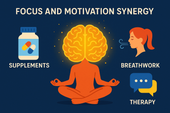
How Nootropic Stacks Can Enhance Drive and Focus Together
Discover how nootropic stacks can reignite both your drive and focus by balancing key neurotransmitters like dopamine and acetylcholine. This in-depth guide explores the science behind motivation, how supplements enhance cognitive performance, and how breathwork and therapy complete the picture for lasting mental clarity. 🧠✨
-
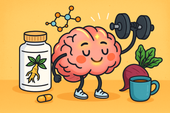
Natural Pre-Workout Supplements for Motivation and Mental Sharpness
Adaptogens are nature’s stress balancers 🌿 — powerful herbs like Ashwagandha, Rhodiola, and Holy Basil that help your body stay calm, focused, and resilient. By regulating cortisol and supporting energy balance, they boost motivation, endurance, and emotional stability — naturally. 🌞🧠
-
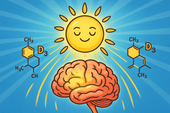
The Role of Vitamin D in Mental Drive and Ambition
Motivation is more than mindset — it’s energy in motion ⚡🧠. It comes from a balance of biology, emotion, and purpose. When your brain, body, and habits align, drive becomes effortless. Learn how to spark consistency, overcome dips, and build unstoppable momentum naturally. 🌿✨
-
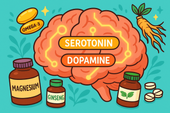
Serotonin, Dopamine, and Motivation: Can Supplements Really Help?
Ginseng is the ultimate vitality root 🌿⚡ — long praised for enhancing focus, energy, and motivation without the crash. By balancing stress hormones, boosting dopamine, and improving brain oxygenation, this adaptogenic powerhouse helps you feel clear, strong, and ready to take action. 🧠✨
-

How Ginseng Helps Support Drive, Motivation, and Energy
Ginseng is nature’s endurance root 🌿⚡ — a timeless adaptogen that fuels focus, drive, and resilience from the inside out. By balancing cortisol, boosting dopamine, and supporting mitochondrial energy, ginseng helps you feel clear, strong, and steady — no crash, just sustainable vitality. 🧠✨
-

The Stress–Motivation Connection: Supplements That Balance Cortisol
Vitamin D — the “sunshine nutrient” ☀️ — plays a crucial role in mental health, motivation, and energy regulation. Low levels can lead to fatigue, low mood, and sluggish focus. Learn how sunlight, nutrition, and supplementation can restore your inner light and boost emotional balance naturally. 🌿🧠
-

When Low Mood Drains Your Drive: Natural Support Options
Vitamin D is more than the “sunshine vitamin” ☀️ — it’s a key player in mood, motivation, and overall brain health. Low levels can lead to fatigue, low drive, and seasonal sadness. Learn how sunlight, supplements, and nutrition can help restore balance and lift your emotional energy naturally. 🌿🧠
-

How Adaptogenic Herbs Help You Stay Consistent
Adaptogens are nature’s resilience enhancers 🌿. From Ashwagandha to Rhodiola and Holy Basil, these herbs help your body adapt to stress, balance cortisol, and maintain steady energy. Learn how they build inner stability — keeping your focus, mood, and motivation consistent through life’s ups and downs. ⚡🧘
-
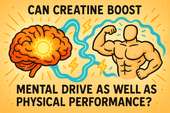
Can Creatine Boost Mental Drive as Well as Physical Performance?
IQ, or intelligence quotient, measures more than problem-solving — it reflects how efficiently your brain processes, adapts, and connects ideas 🧠⚡. While genetics play a role, lifestyle, nutrition, and brain health all influence cognitive performance. Learn how to support mental sharpness and cognitive growth naturally. 🌿✨
-
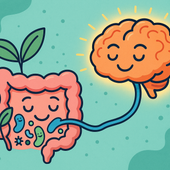
The Link Between Gut Health and Motivation: Probiotics Explained
Serotonin — the “feel-good” neurotransmitter 🌞 — plays a powerful role in mood, motivation, and overall emotional balance. Produced mostly in the gut, it connects digestion, happiness, and focus through the gut-brain axis. Learn how to naturally support serotonin for calmer energy and lasting motivation. 🌿✨
-

How B Vitamins Fuel Motivation and Energy at the Cellular Level
B vitamins are the body’s natural energy engines ⚡. They convert food into fuel, support dopamine for motivation, and power brain cells at the mitochondrial level. From B1 to B12, these nutrients help you stay focused, resilient, and full of drive — every single day. 🌿🧠
-

Supplements That Support Mental Endurance for Long Projects
Mindset is more than motivation — it’s the mental framework that shapes how you respond to challenges and pursue goals 🌿🧠. A growth mindset turns obstacles into opportunities, while a fixed mindset fuels self-doubt. Learn the science behind mental resilience and how to cultivate a mindset that sustains focus, creativity, and long-term success. ✨
-

How Omega-3s Influence Drive, Creativity, and Problem-Solving
Sleep isn’t just rest — it’s the foundation of mental clarity, emotional balance, and motivation 🌙💤. During deep sleep, your brain resets stress hormones, consolidates memory, and clears away mental fog. Learn how better sleep supports neuroplasticity, creativity, and lasting energy for your day. 🌿✨
-
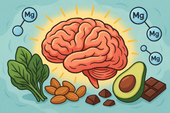
Can Magnesium Improve Your Focus and Motivation?
Caffeine is the world’s favorite stimulant ☕ — boosting alertness, sharpening focus, and lifting motivation within minutes. But there’s real science behind that morning cup. Learn how caffeine works on adenosine and dopamine, how to avoid the crash, and how to use it strategically for sustained energy and mental performance. ⚡🧠
-

The Role of L-Theanine and Caffeine in Daily Motivation
Cortisol — often called the “stress hormone” — is both your alarm system and your reset button ⚡. It keeps you alert in the morning and helps you recover after challenges, but when it stays high too long, it drains your mood and energy. Learn how to balance cortisol naturally for steady focus, calm, and motivation. 🌿
-
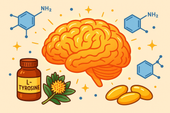
Supplements That Support Dopamine for Drive and Reward
Curcumin — the golden compound in turmeric — is more than a spice 🌿✨. It’s a powerful anti-inflammatory that protects dopamine neurons, supports brain clarity, and enhances mood. Learn how curcumin’s antioxidant properties help stabilize energy, reduce brain fog, and promote emotional resilience naturally. 🌼
-
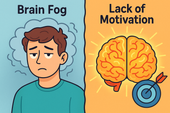
Brain Fog vs Lack of Motivation: What’s Really Holding You Back?
Hormones are the body’s invisible messengers — shaping energy, mood, focus, and motivation 🧠🌿. When they’re balanced, you feel clear, confident, and emotionally steady. Learn how key hormones like cortisol, serotonin, dopamine, and estrogen interact to influence your mental well-being and what you can do to keep them in harmony naturally. ✨
-

Supplements for Staying Collected During Disagreements
Science helps us understand why we feel, react, and change 🌿🧠. From brain chemistry to neurotransmitters and hormones, every emotional response has a biological root. Explore how research in neuroscience and psychology reveals practical ways to stay balanced, focused, and emotionally strong in daily life. 🔬✨
-

Managing Anger While Traveling
Supplements can help calm your nervous system and keep your emotions balanced while on the go 🌿. From magnesium and ashwagandha to L-theanine and omega-3s, learn how natural nutrients support stress resilience, focus, and emotional control — even through long flights, delays, and unpredictable travel days. ✈️
-

How to Keep Your Temper in Online Debates
Supplements can do more than fill nutritional gaps — they can help balance your energy, focus, and stress response naturally 🌿. From adaptogens to amino acids, the right nutrients support your brain chemistry and hormonal harmony for calm, steady productivity. Discover how supplements can build long-term resilience without the crash. ⚡🧠
-

Supplements to Stay Calm Before Public Speaking
Breathwork is one of the simplest yet most powerful tools for calming pre-performance stress 🌬️. By slowing and deepening your breathing, you lower cortisol, steady your heartbeat, and re-center your mind. Learn the science behind how controlled breathing activates your parasympathetic nervous system — helping you speak, perform, or focus with grounded confidence. 🌿
-

How to Handle Customer Service Stress Without Losing Your Cool 💬🧘♀️
Customer service can test even the calmest person’s patience. 😤 Learn how to handle difficult clients and daily pressure without losing your cool — through better mindset management, calming breathwork, and practical communication tools. Stay grounded, protect your energy, and transform stress into strength. 🌿
-

How Adaptogens Like Ashwagandha Keep You Motivated Under Stress
Feeling overwhelmed and unmotivated? 🌿 Discover how adaptogens like Ashwagandha can help you stay centered, focused, and energized under stress. Learn how supplements, breathwork, and therapy work together to restore your natural motivation and help you thrive — even during life’s toughest moments. 💪✨
-

Supplements That Support Long-Term Productivity Without the Crash ⚡🌿
Cortisol — your body’s main stress hormone — can be both your best friend and worst enemy. ⚡ When balanced, it keeps you focused, energized, and ready to act. But when it stays high for too long, it leads to fatigue, anxiety, and emotional crashes. Learn how to regulate cortisol naturally through supplements, sleep, and stress management to maintain calm, steady productivity. 🌿
-

Why Energy Levels and Motivation Go Hand in Hand ⚡🧠
B-vitamins are the brain’s spark plugs 🔋. They turn food into fuel, support neurotransmitter production, and keep your mood, energy, and focus balanced. Learn how vitamins like B6, B9, and B12 work together to power the nervous system, reduce fatigue, and keep motivation high. 🌿
-
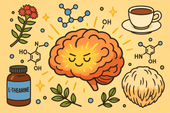
The Science of Motivation: Can Nootropics Help You Stay Focused? 🧠⚡
Nootropics are nature’s tools for sharper thinking and sustainable focus 🧠🌿. From Rhodiola and Lion’s Mane to L-theanine and Bacopa, these brain-boosting compounds enhance motivation, memory, and stress resilience. Learn the science behind how nootropics work — and how to use them safely for peak mental performance and clarity. ⚡
-
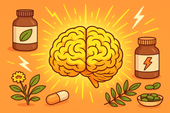
How Natural Supplements Can Boost Your Daily Drive
Cortisol is your body’s main stress hormone — powerful, necessary, but often misunderstood. ⚡ When balanced, it keeps you alert and energized; when chronically elevated, it drains mood, motivation, and focus. Learn how to regulate cortisol naturally through nutrition, supplements, and calming lifestyle habits for steady energy and emotional balance. 🌿
-

Ashwagandha for Stress and Low Mood
Breathwork is more than a relaxation tool — it’s a way to rewire your nervous system. 🌬️ Through intentional breathing, you can reduce stress hormones, improve focus, and calm emotional turbulence. This guide explores the science of breathwork and its powerful effects on mental clarity, resilience, and emotional regulation. 🌿
-

Mood-Boosting Smoothie Recipes
Your blood sugar affects far more than energy — it influences mood, focus, and emotional stability too 🍎. Learn how maintaining balanced glucose levels supports brain health, reduces anxiety, and prevents emotional crashes. Discover the foods and habits that keep your mind calm and your energy steady throughout the day. 🌿
-

How Healthy Fats Support Brain Function
Your brain thrives on healthy fats 🧠💧. From omega-3s to MCTs, the right fats enhance focus, memory, and mood while protecting against inflammation and aging. This article explores how good fats — like those from olive oil, salmon, avocado, and nuts — build sharper thinking, emotional balance, and lasting brain vitality. 🌿
-
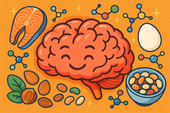
The Role of Protein in Mental Clarity
Protein isn’t just for muscles — it’s for your mind. 🧠 This guide explores how amino acids from high-quality protein fuel neurotransmitters, stabilize mood, and sharpen focus. Learn how balanced protein intake supports dopamine, serotonin, and energy regulation to boost mental clarity and emotional stability naturally. 🍳🌿

















































